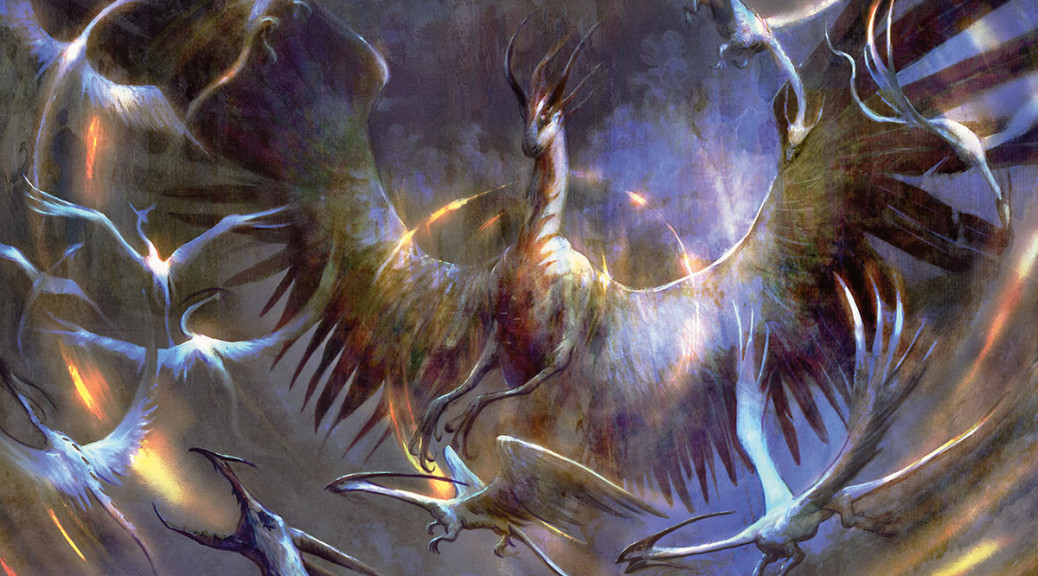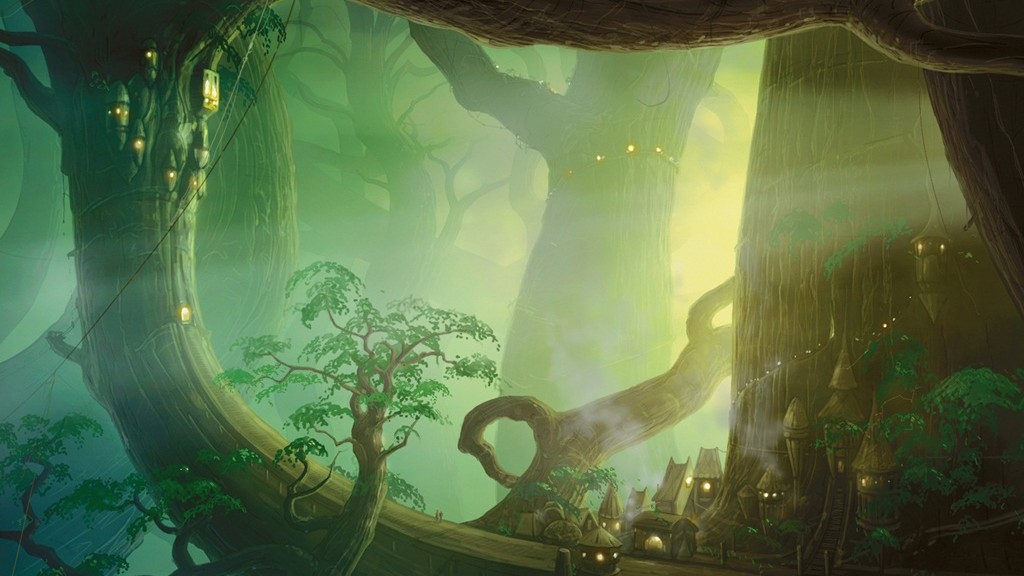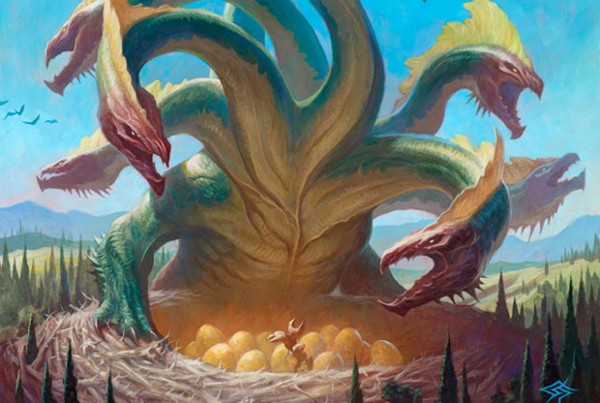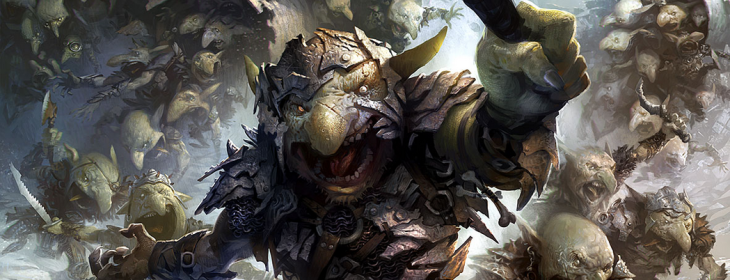Are you joining this series in the middle? That’s cool, but be apprised that you’re doing that. If you want to catch all of the references I’m referring to, you can always catch up really quickly if you are so inclined: part one introduced the series and talked about Orzhov and part two discussed Golgari.
Today, I get to talk about my favorite color combination: green-blue. This is going to be a real bummer, because Simic always seems to suck. It’s usually the worst of any given cycle and the mechanics we get are always seem disappointingly slow for Standard. Have fun dicking around with graft—Dimir just stripped your hand and then transmuted for its combo pieces. Still, there are some things that Simic does well, and Kruphix and his Prophet all but made up for the degree to which it seems like Simic has been pooped on. Besides, it’s not always bad: Pygmy Hippo is way better than Mundungu. Well, in EDH, anyway.
What is Simic good at according to the Wiki article I’ve been referencing these last few weeks?
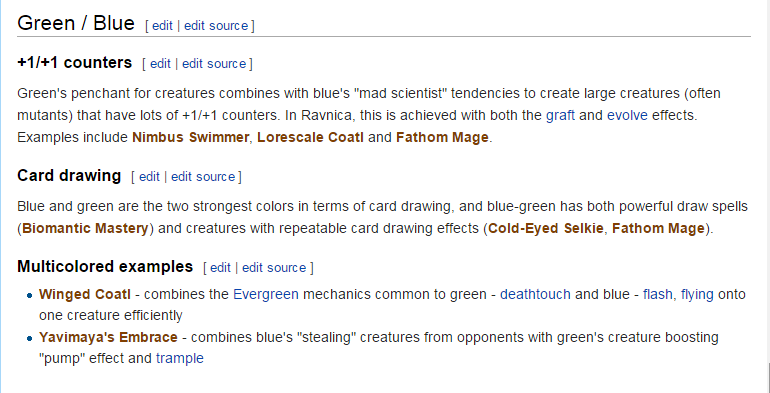
I’m far from overwhelmed, here. Still, with a lack of probable effects to build a deck around comes increased certainty vis-a-vis the cards likely to be in the deck. The choice is literally almost just, “A +1/+1 counter deck that has card drawing, because of course it has card drawing—there’s blue in it.”
So what are we likely to see if these are the abilities that the deck is built around? Is there a Wurmcoil equivalent here?
+1/+1 Counters
A lot of these cards are pretty bad, frankly. I may end up retreading some cards I’ve already talked about, but we’re trying to judge them with respect to their likelihood to see a reprinting, so why not mention them again?
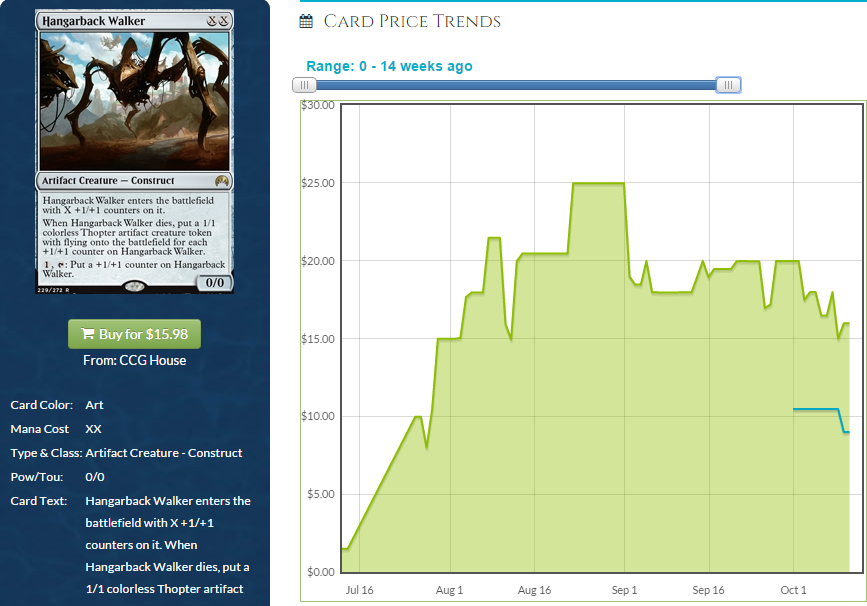
I don’t think Hangarback Walker is at all likely. The event deck took care of this reprinting and sent it “plummeting” to $15 down from $20. As much as this would be a solid card in a deck like we’re expecting, and as much as this might be an interesting Wurmcoil corollary, I have to imagine this is safe. Copies should be pretty stable moving forward.
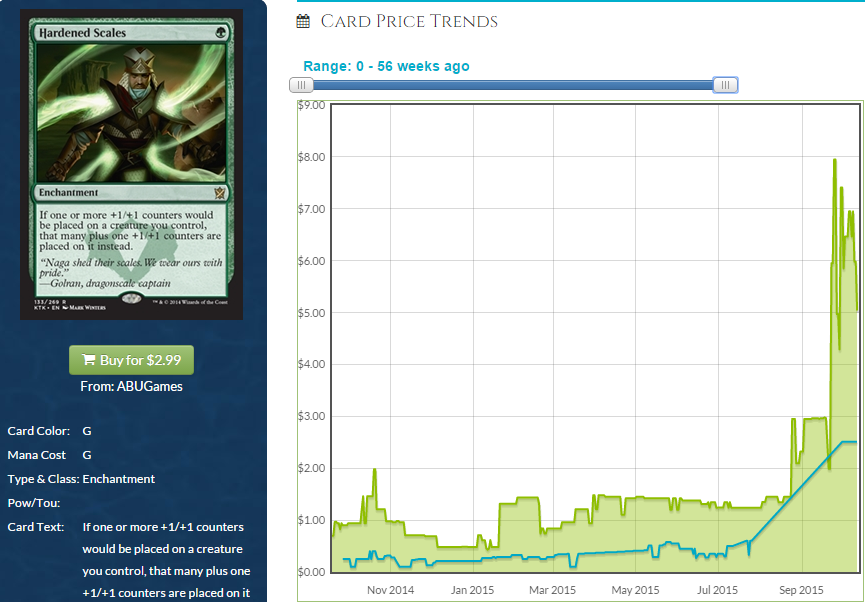
I was always as bullish on this card as a person could possibly be, but I didn’t anticipate it hitting $5 this soon. This might be a nice card to reprint into mush and it wouldn’t hurt a deck with a counters theme, either. If you have these, I think you ship them if they start to tail down a bit more—quintupling up in a week usually means the growth is gassed, at least for a while. This card is going to make a small splash in Standard, but it would need to be a staple to be worth enough money that you regret shipping these for $5. If you got these cheap, shipping to a buylist for $2.50 seems fine and no one would blame you. I’m glad I got prerelease-stamped copies for personal use by trading for them, since everyone seems to be sold out of foils, which is odd to see when a Standard card spikes. That smacks of speculation rather than organic growth.
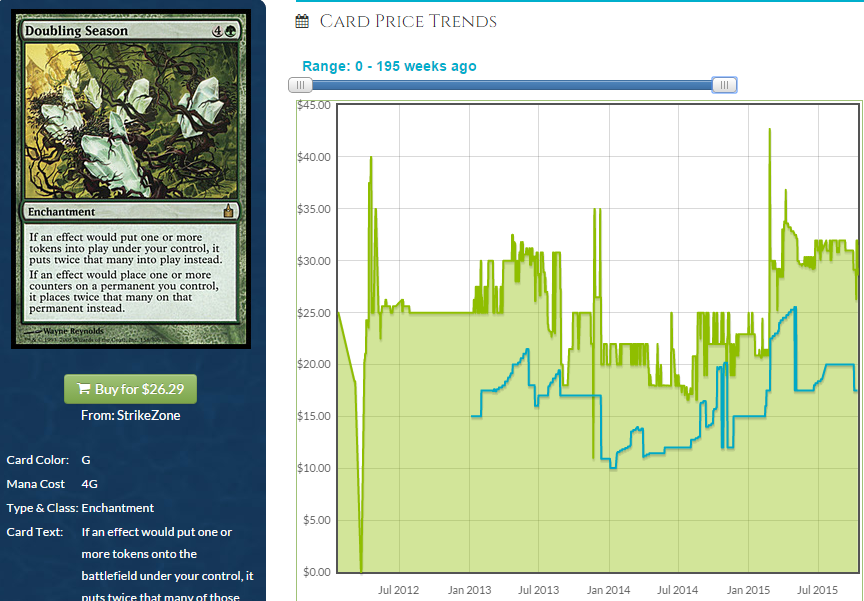
The Modern Masters reprinting didn’t really make much of a dent in Doubling Season‘s price, did it? I realize this isn’t all that likely, but this would be a good way to bring this price down, provided that’s even something Wizards cares about. Primal Vigor seems even less likely to me, because there is no precedent for reprinting a card originally printed in a Commander deck in a subsequent one. However, I did say it wasn’t out of the question to see a reprinting of Scavenging Ooze in the Golgari deck so maybe this isn’t out of the question. There’s not a ton of money to be lost by not selling, because I expect the Simic one to be the worst-selling of the this year’s five decks—unless it gets a very good Legacy card (which is possible given how good blue is in Legacy). Thus, Doubling Season and Primal Vigor might be safe-ish price-wish, even if reprinted. There just aren’t a ton of cards that help the strategy. The bulk of the stuff is going to be creatures rather than spells.
This article talked a bit about similar cards and I feel like I’ve talked about hydras as well. There are cards worth mentioning, since we’re very likely to see a deck that has a new commander, has Vorel of the Hull Clade in the 99 and takes enemies to hydra town if we’re trifling with +1/+1 counters.
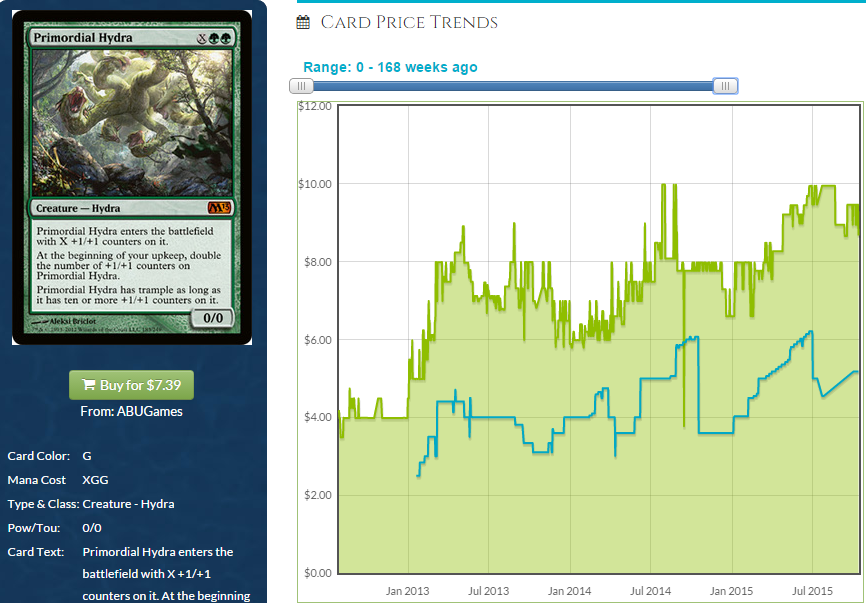
I have no strong feelings one way or another. This seems like a solid choice in a deck with counters, but it’s by no means the best hydra when you are trying to build a synergistic deck. I imagine Wizards will insert a few hydras, all of them around $5 now, or maybe one more expensive hydra. I’d like to see a lot of them, but that would take bulky hydras and make them true bulk, which isn’t necessarily good. Besides, there are a finite number of rare spots in the deck and they can’t all be hydras. Still, this is a fine inclusion that is very good and gets out of hand fast.
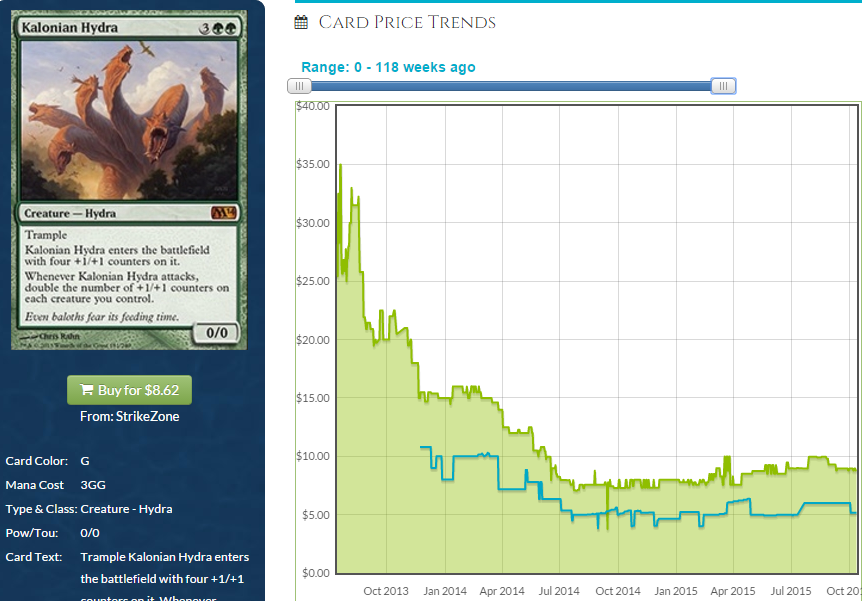
Kalonian Hydra seems like a better choice. Around the same price as Primordial Hydra, this doesn’t have multiple printings, but it does make your creatures with counters on them get huge. If this doesn’t end up in the precon, I would expect renewed interest in the card. This is a very, very good creature, and since it can buff the rest of your team, can get out of hand quickly. I would like to see this.
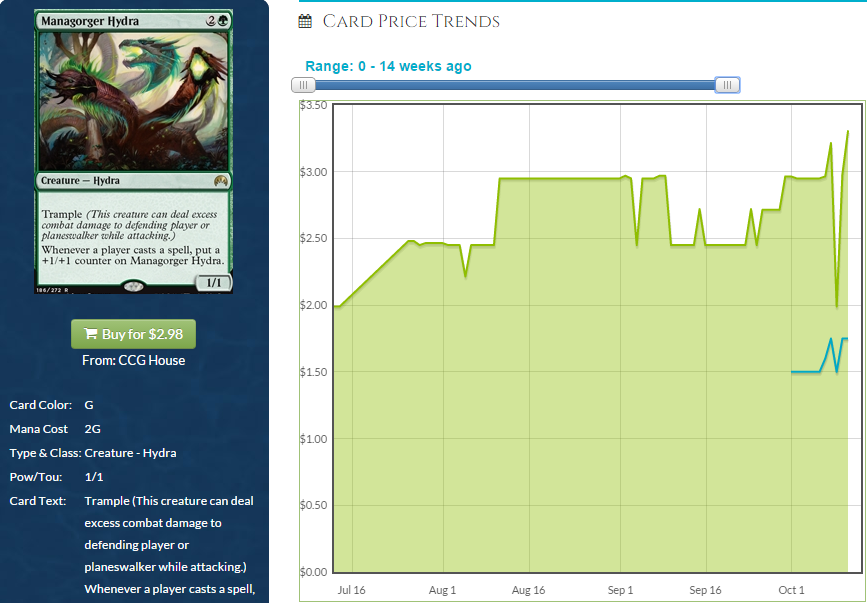
As much as a reprinting could nip this in the bud before it even got started, this would be a fine inclusion. This plays a lot like Taurean Mauler, which is an EDH staple, and also happens to benefit from having trample. While there is no real actual hydra commander for a hydra tribal deck, we could see that in this year’s Simic Commander deck—and that would make hydras more popular. I think this would be hurt by a reprinting, but I don’t think Wizards cares about that, and getting these out there in the deck would be fine. This is a solid card and seems a likely inclusion if the deck cares about counters.
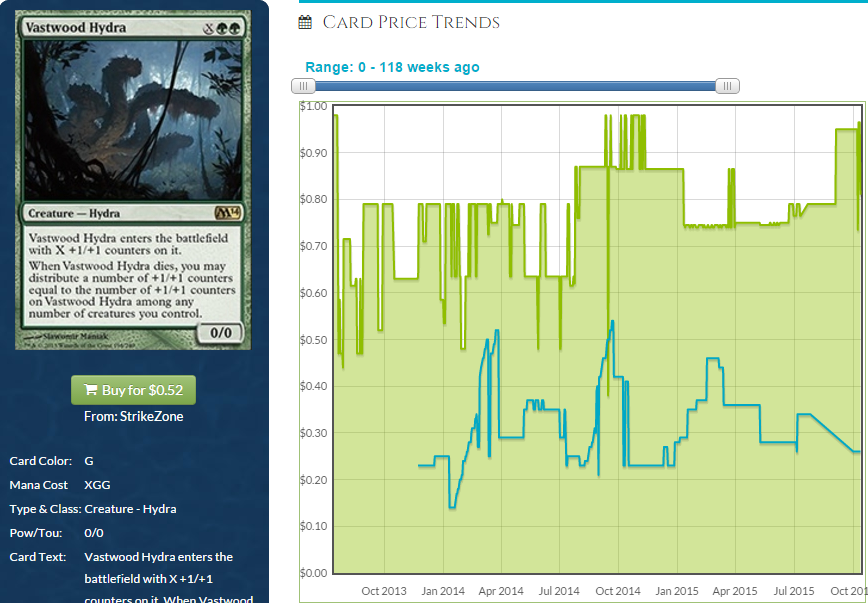
There’s no money to be made or lost here either way, but how good is this with Hardened Scales?
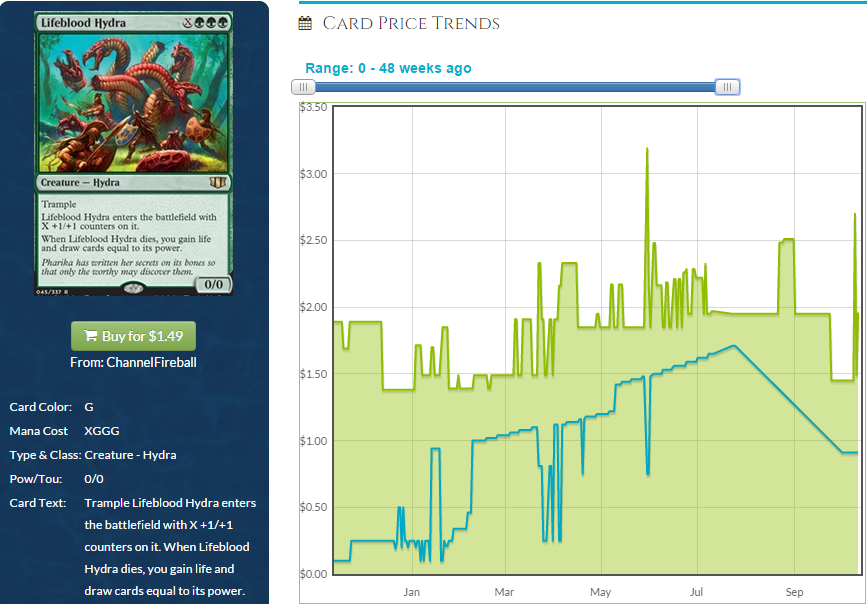
Again, how likely is it that Wizards reprints a card that was originally in a Commander product? Last year’s at that? There seems like a zero-percent chance of this being in the deck, but I think this could get even more popular as people want to build decks where counters matter.
There are other cool hydras, and I am sure a few of them are decent candidates. However, hydras aren’t the only creatures that care about +1/+1 counters.
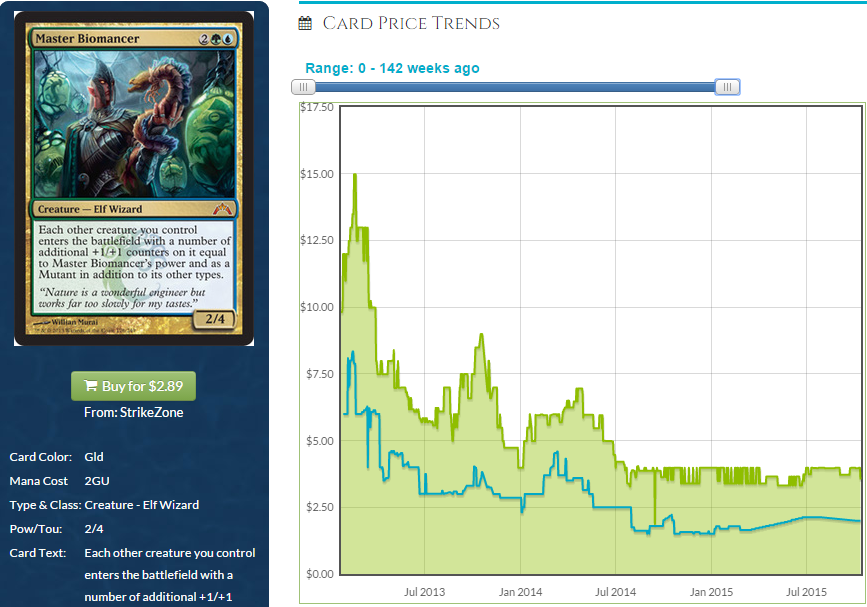
This card with a few counters on it soon gets pretty saucy. I have this in my Vorel deck, and I’m never upset to draw it. Adding extra counters because of Hardened Scales or Doubling Season feels even better. I don’t see a reason not to put this in the precon, so I guess it’s all a matter of which rares Wizards thinks need to go in. There isn’t much money to be saved by selling these now, but the reprint kills it as a spec, so be careful. I don’t see it getting a ton cheaper, so the time to buy these may be soon if this escapes a reprint.
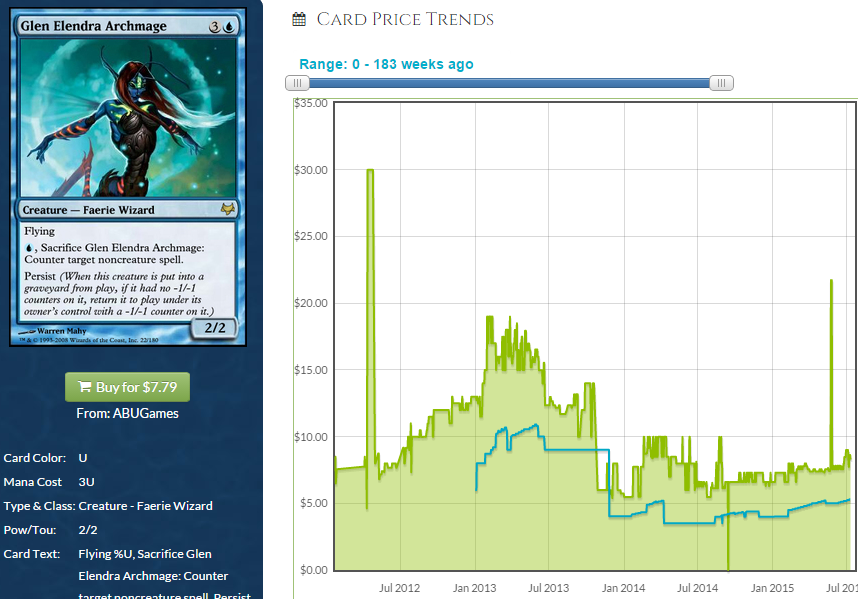
If you can add counters and get rid of the persist counters, this might be a good inclusion. Will Wizards want a combo like that in its precon? Either way, this is a good card going forward, and while this would be a third printing, I don’t know that I want to 100-percent rule this out. This has room to grow if it’s not reprinted.
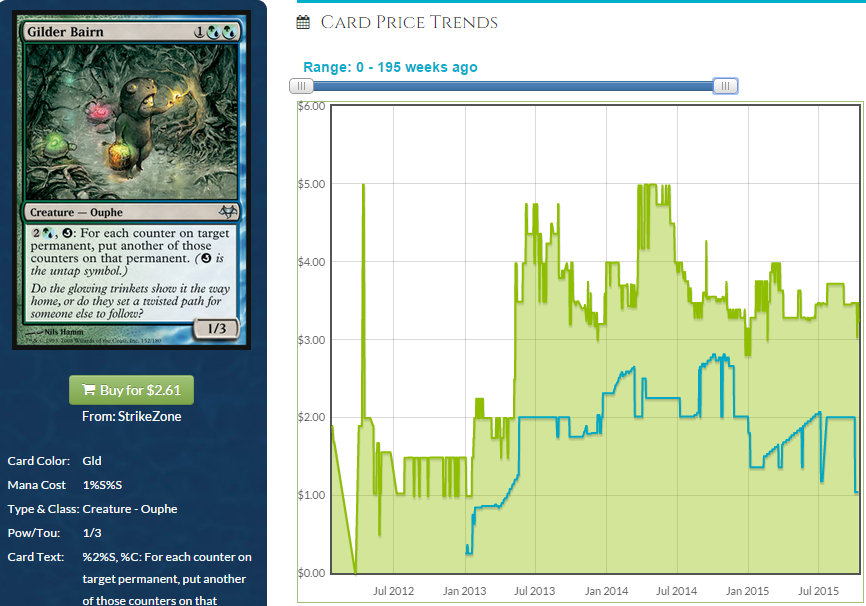
Right? This seems like a shoo-in to me, which is good since uncommons shouldn’t necessarily be this expensive. The spread has increased radically since I last wrote about this card, but I am still bullish about its long-term growth potential. This is a very good inclusion in the deck but should we not see it reprinted, I like it long-term. Set-specific mechanics like untap abilities narrow reprint potential, after all, but that wouldn’t exclude it from consideration in a Commander precon, so it feels a little unsafe right now.
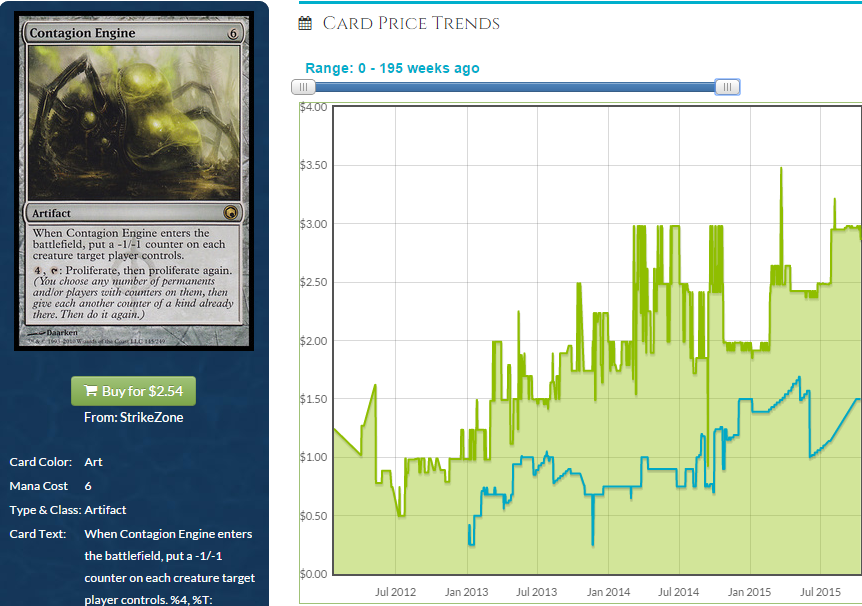
I have written about a lot of these cards before, but in the context of a UG deck that almost has to deal with counters, some of these seem less safe than they did a few months ago. How would you build a UG precon deck if you had to? What would you put in it?
Card Drawing
How broad. Blue draws cards and every time green helps out it’s either based off of creatures or is a functional reprint of a blue card. The times they combined the two, we get a card like…
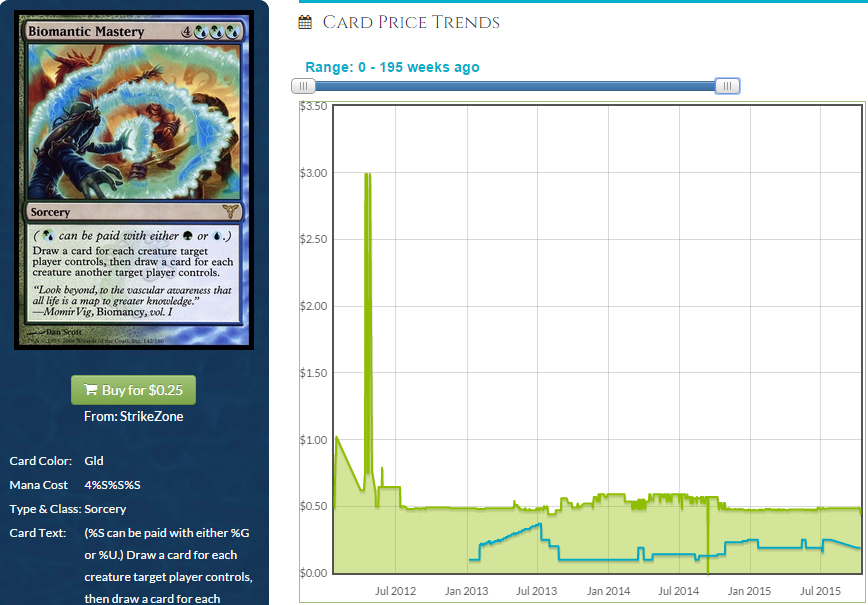
…Bulkomantic Mastery.
Are we going to see Shamanic Revelation or some other relatively color-specific card, or are we going to see cards that combine blue and green together to draw cards? There are some that aren’t terrible.
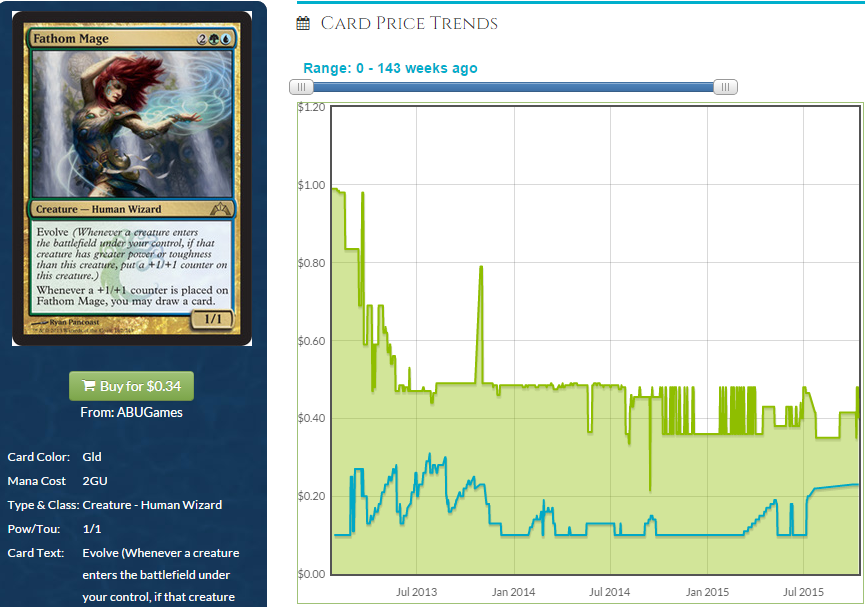
There’s no money to be made or lost with Fathom Mage, but this is a solid card that combines the elements of blue and green, draws cards, plays nice with +1/+1 counters, and is really fun to use.
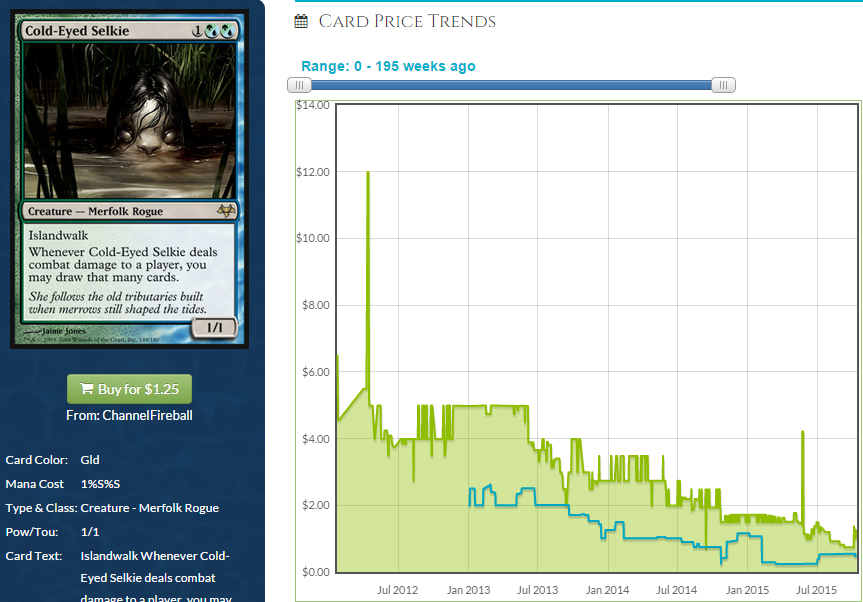
Modern Masters reprinted this card into powder, and it hasn’t recovered yet, given how its inclusion in Legacy decks seems to be a thing of the past. Still, this is how blue and green draw cards and islandwalk makes this a threat, especially if you put equipment on it. Still, how much money do you lose if you don’t sell these in anticipation of the precon? None, that’s how.
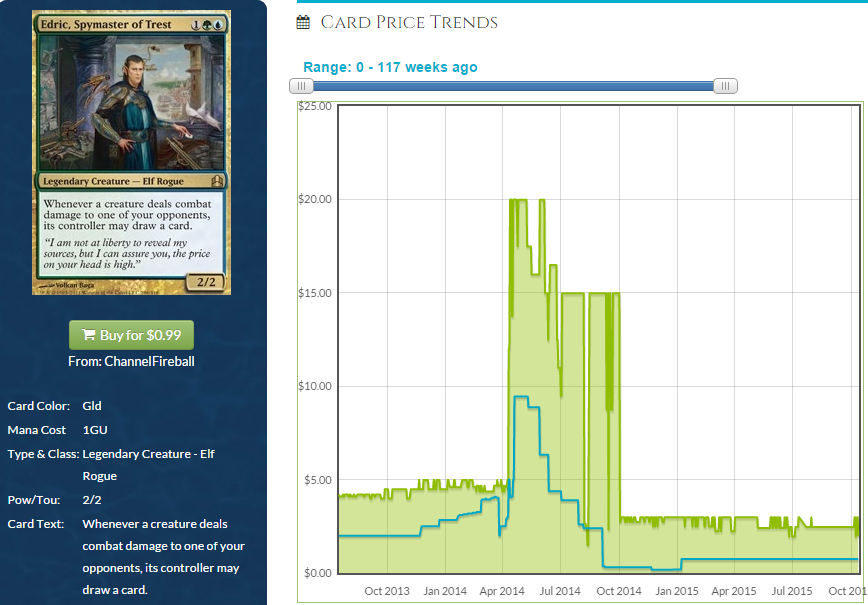
There are two ways to get Edric in foil and those may be a better bet. This card doesn’t need a reprinting but I can’t rule it out.
Should I list card drawing stuff in EDH? Rhystic Study is basically the one to watch: everyone knows it’s good, and I don’t know how likely it is to get reprinted. Instead, I want to devote the rest of my word count (and probably like 200 or 300 words beyond it) to talk about Simic cards that I think might be good in the deck but don’t necessarily deal with +1/+1 counters or card drawing. I’m going to do that in the most confusing way possible, by starting with a card that does deal with counters.
Miscellany
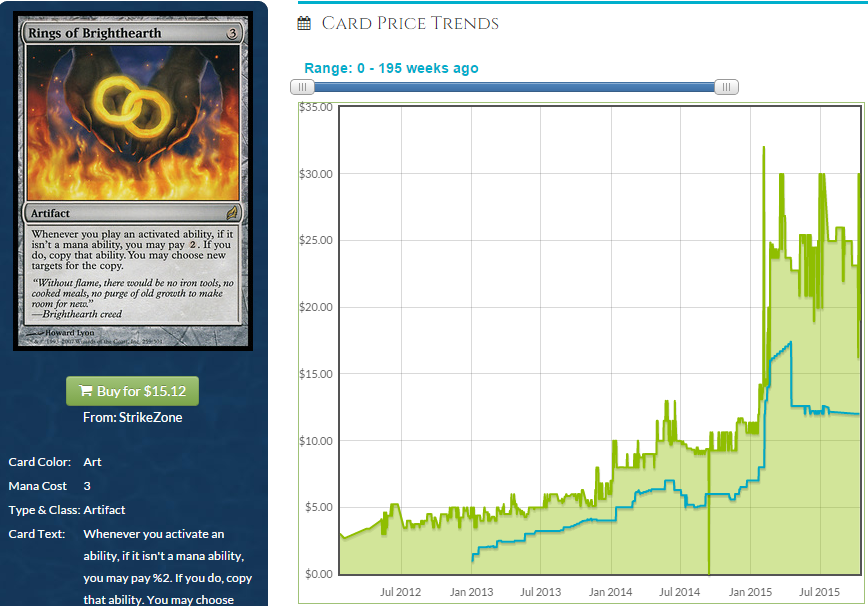
This would be included just to give us something that worked well with +1/+1 counters. That said, this also works well with just about anything. This card is expensive because MTG financiers convinced themselves Tiny Leaders was a thing. When is the last time you heard anyone mention Tiny Leaders? Forever ago, right? Well, just being wrong about a format getting traction doesn’t mean there won’t be real consequences, and the consequence for this card was that it reached $15 a few years too early. It would likely have hit $15 without intervention eventually, so a reprint is not unwelcome. Rings of Brighthearth could be this deck’s Wurmcoil, although it would be tricky to justify it if it doesn’t work pretty intimately with the theme of the deck. A lot of the abilities on the creatures and enchantments are triggered. Strionic Resonator does a lot of work in my Vorel deck, although this does double planeswalker loyalty counters, Vorel himself, and some other key abilities. I’d like to see a reprinting of this card, but only if it makes sense with the deck’s theme.
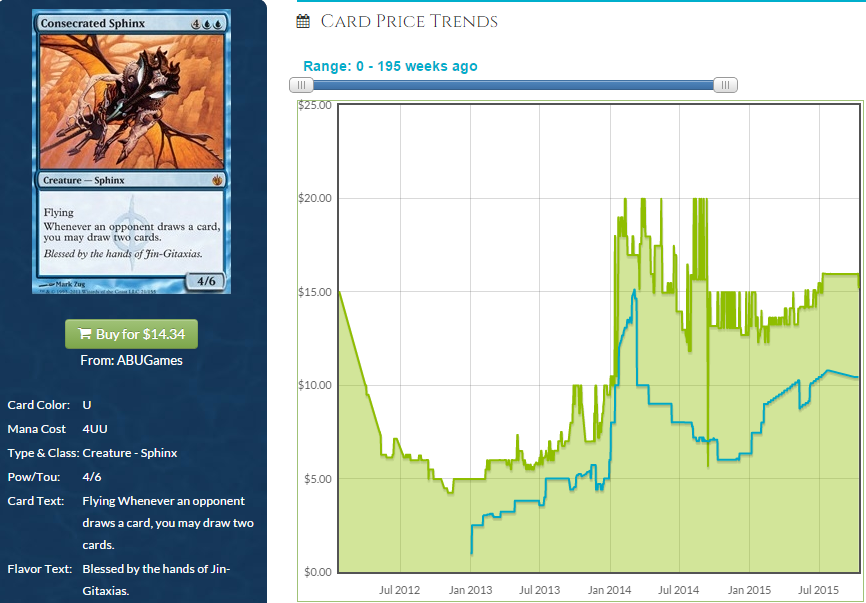
…and Consecrated Sphinx deals with card drawing. I could easily go back and change that paragraph where I said I wasn’t going to necessarily name cards that dealt with those concepts. but I’m not going to, because it’s way funnier to me not to.
This is controversial for another reason. This card is discussed as bannable because it’s stupid. You either kill this, steal it, clone it, or lose to the player that has it. Still, this is expensive and this deck makes more sense as a reprint venue than the UR deck. Still, I think this is safe for now.
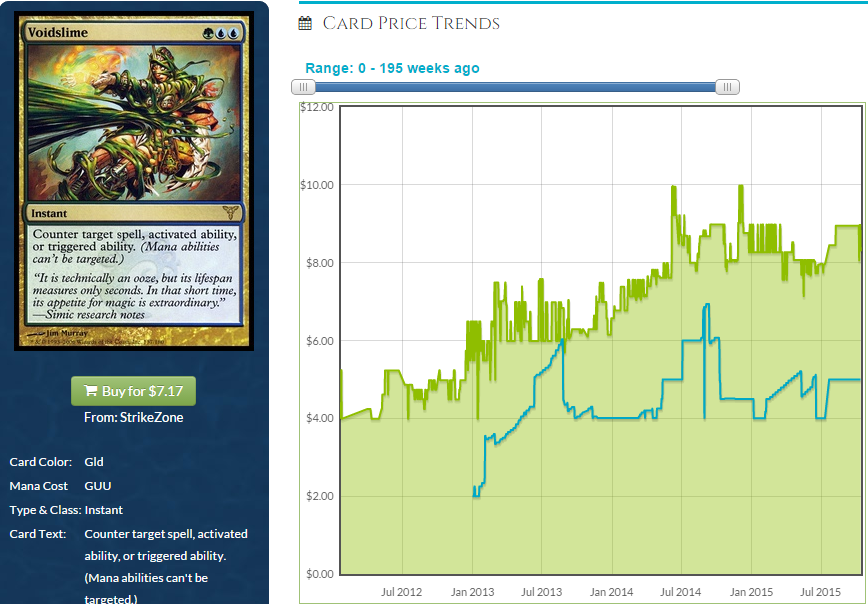
This seems like a good candidate. The reprinting would curb its price and increase its availability for one. This isn’t exactly Wurmcoil tier, but bringing the price down forever would be okay. The good thing about EDH cards is that a lot of the people who have the cards play with them every week and likely won’t even notice the price went down. If they do, they will be happy they can afford more copies for other decks. I think this seems like a decent choice to jam in the Simic deck.
The Difficulties of Being Simic
It’s hard to identify cards in Simic that were like Wurmcoil Engine in the red precon from last year: $15 plus or minus a few bucks, played a lot, unlikely to tank largely in value even after the reprint, and cards that players need. I have mostly UG decks, and while I could rattle off cards like Black Market quickly for the Orzhov and Golgari decks, I’m at a bit of a loss here.
The problem with Simic? It has two types of cards: cards that aren’t very good and cards that are so good they’re unfun. Are we going to see Deadeye Navigator and Great Whale? Palinchron? Prophet of Kruphix? Consecrated Sphinx? There are so many cards that are controversial due to how good they are and how every player that plays those colors seems to use them, and Simic has a lot of those cards. I think it means the cards I do have somewhat of an inkling they could see printing could be more likely due to a smaller field of candidates. It also means they could skip all of those cards and the Simic deck could be total trash.
Will we see any hydras at all? Will there be a Momir Vig type theme with mutants rather than +1/+1 counters? Will Wizards not reprint anything over $5 and put all of the value in a card that is new and will be good in Legacy? Will something from a previous precon be reprinted, like Shardless Agent, Scavenging Ooze, or Lifeblood Hydra? It’s hard to say.
I almost did this color combination last since, it’s the trickiest, but I’m going in the order of that stupid wiki and that’s how I live my life. I expect a lot of disagreement on this one, and I welcome it this week. I may play too much Simic to see around my own biases, so let’s hear what you all think.
As always, it’s been a pleasure and I’ll be back next week with Izzet—and we will likely have some spoilers to discuss also. Until then!
